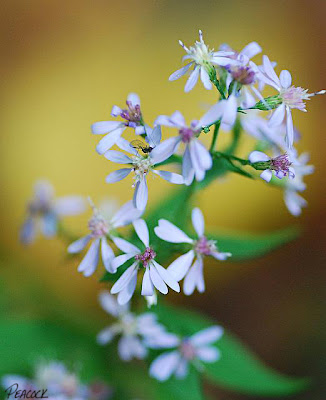 There are a couple of things about the above shot that I wish I could do-over. I didn't notice the bug until later, kinda wish it was gone - but I guess you could say that it adds interest. I also wish I had a bit more depth of field to get more of the flower in focus. But there are no mulligans in photography (just hours and hours of photoshop work). What I like about this photo is the yellow background, made possible by the fact that we now have big, bright yellow poplar leaves laying all over our trails. This makes adding color to any macro shot easy. Just be sure to use a large aperture to blur the background -- this was f/3.8. It's a trade off between wanting the smooth, blurry background and needing depth of field. Professional photographers call these blurry backgrounds 'bokeh' (pronounced bo-kah) which comes from the Japanese word for blurriness or dizziness. By blurring the background the photo takes on a pleasing aesthetic -- with the principle subject becoming more prominent and the overall feel of the photo becoming softer.
There are a couple of things about the above shot that I wish I could do-over. I didn't notice the bug until later, kinda wish it was gone - but I guess you could say that it adds interest. I also wish I had a bit more depth of field to get more of the flower in focus. But there are no mulligans in photography (just hours and hours of photoshop work). What I like about this photo is the yellow background, made possible by the fact that we now have big, bright yellow poplar leaves laying all over our trails. This makes adding color to any macro shot easy. Just be sure to use a large aperture to blur the background -- this was f/3.8. It's a trade off between wanting the smooth, blurry background and needing depth of field. Professional photographers call these blurry backgrounds 'bokeh' (pronounced bo-kah) which comes from the Japanese word for blurriness or dizziness. By blurring the background the photo takes on a pleasing aesthetic -- with the principle subject becoming more prominent and the overall feel of the photo becoming softer.Here's another bokeh example of a flower taken this summer...


Your photos are quite beautiful!
ReplyDeleteI am no photographer, but I do like to take pictures (my camera stays on the 'automatic' setting). Your first photo reminds me of one I just took in the Smokies, which has a blurry background, possibly a bokeh, seen here.
I am not sure how I found your blog, possibly from one of the many Floyd VA folks, but will be back to enjoy your photos, thanks for sharing.
BOKEH!!! You and Lee taught me bokeh. =) Great shots Mark!
ReplyDeleteSorry to say this, but there is no bokeh in that photograph. Bokeh specifically requires unfocused points of light/highlights in the background. Bokeh means more than just shallow depth of field.
ReplyDeleteDo a Google Image search for bokeh and you'll see what I mean.